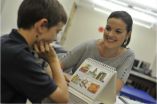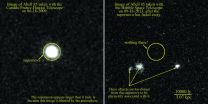(Press-News.org) CINCINNATI - Researchers have identified that parent-reported responses to a questionnaire called the Pediatric Eosinophilic Esophagitis Symptom Score (PEESS® v2.0) correspond to clinical and biologic features of eosinophilic esophagitis (EoE) - a severe and often painful food allergy that renders children unable to eat a wide variety of foods.
This study, published online in Journal of Allergy and Clinical Immunology, was led by researchers at Cincinnati Children's Hospital Medical Center.
Eosinophils are normal cellular components of the blood, but when the body produces too many eosinophils they can cause a variety of eosinophilic disorders. These are disorders involving chronic inflammation and resulting in tissue damage, often in the gastrointestinal system.
The current focus for evaluating treatment involves looking at changes in the tissues and cells of the esophagus. However, to improve both clinical outcomes and patients' quality of life, there is a need to objectively measure and consider both patients' symptoms and how they feel, according to the research team.
"Because eosinophilic esophagitis is a disease with multiple symptoms, the ability to capture patient and parent perceptions of these symptoms is a major unmet need," says Lisa J. Martin, PhD, professor of Human Genetics at Cincinnati Children's and first author of the study. "By having validated tools to measure how patients feel, our reported findings provide a new opportunity for evaluating treatments going forward. The validation of the PEESS symptoms with biologically and clinically pertinent assessments is therefore a major step forward for improving the outcomes in patients with EoE."
The authors of this study recruited pediatric patients with eosinophilic esophagitis. The PEESS® v2.0 questionnaire measured symptoms and their impact. On the basis of a previous study, the authors grouped these questions into four categories that represent the major symptom types observed in eosinophilic esophagitis--dysphagia, gastrointestinal reflux disease, nausea/vomiting, and pain.
The study demonstrated that these four PEESS v2.0 symptom categories were meaningful. Each corresponded with clinical symptoms of eosinophilic esophagitis. Importantly, the biologic features most closely aligned with the dysphagia category. However, dysphagia only modestly corresponded with the main biologic measure of disease activity, eosinophil number. Interestingly, dysphagia more closely associated with eosinophil activity, mast cells, and gene expression. Eosinophil activity is a marker of immune cell activity. Mast cells are immune cells involved in the development of eosinophilic esophagitis. These results suggest that eosinophil activity and mast cells may contribute to dysphagia symptoms.
Using the Eosinophilic Esophagitis Diagnostic Panel, a set of 94 genes expressed in the esophagus, the authors linked particular genes with the categories, thus revealing key steps involved in the clinical manifestations of this disease.
This study is the first to validate the PEESS v2.0. This work is an essential step toward improving the outcomes of patients with eosinophilic esophagitis. With the PEESS? v2.0 categories, researchers can better track disease activity in clinical settings, and this instrument can be used to test the impact and benefit of new therapies. The categories will also aid diet intervention and drug trials. Long term, this work may help identify the biologic pathways to target for intervention.
Allergic diseases have been on the rise over the past 20 years, with approximately one of every 13 children having food allergies and over 2.5 million children suffering from allergic asthma. Only recently recognized as a distinct condition, the incidence of EoE has also been increasing, according to Marc E. Rothenberg, MD, PhD, Director of the Division of Allergy and Immunology, the Cincinnati Center for Eosinophilic Disorders, and a co-author on the current study.
Rotenberg and his laboratory team pioneered research showing that EoE has a reported incidence estimated to be approximately 1 out of 1,000 people, is caused by a combination of genetic and environmental factors, and is primarily mediated by an immunologic response to foods. The hallmark of EoE is swelling and inflammation in the esophagus, accompanied by high levels of immune cells called eosinophils.
EoE can affect people of any age but is more common among young men who have a history of other allergic diseases, such as asthma and eczema. EoE is often first discovered in children with feeding difficulties and failure to thrive, but it is often misunderstood and not well known, delaying proper diagnosis and treatment.
INFORMATION:
Funding support for the study came from the National Institutes of Health (R01 DK076893-03S1), Campaign Urging Research for Eosinophilic Disease (CURED), Food Allergy Research and Education (FARE), and Buckeye Foundation.
Related links
Rothenberg lab:
http://www.cincinnatichildrens.org/research/divisions/a/allergy-immunology/labs/rothenberg/default/
Rothenberg lab Facebook page:
http://www.facebook.com/RothenbergEosinophilicLab
Cincinnati Center for Eosinophilic Disorders:
http://www.cchmc.org/cced
Cincinnati Center for Eosinophilic Disorders Facebook page:
http://www.facebook.com/CCEDeos
About Cincinnati Children's
Cincinnati Children's Hospital Medical Center ranks third in the nation among all Honor Roll hospitals in U.S. News and World Report's 2014 Best Children's Hospitals. It is also ranked in the top 10 for all 10 pediatric specialties. Cincinnati Children's, a non-profit organization, is one of the top three recipients of pediatric research grants from the National Institutes of Health, and a research and teaching affiliate of the University of Cincinnati College of Medicine. The medical center is internationally recognized for improving child health and transforming delivery of care through fully integrated, globally recognized research, education and innovation. Additional information can be found at http://www.cincinnatichildrens.org. Connect on the Cincinnati Children's blog, via Facebook and on Twitter.
ITHACA, N.Y. - Ask a plant researcher how the sex of a cucumber plant is determined and the person will tell you, "It's complicated." Depending on a complex mix of genetic and environmental factors, cucumbers can be seven different sexes. Some high-yield cucumber varieties produce only female flowers, and a new study identifies the gene duplication that causes this unusual trait.
The study, led by Zhangjun Fei of the Boyce Thompson Institute at Cornell University, and Sanwen Huang of the Chinese Academy of Agricultural Sciences, in Beijing, appeared recently in The Plant ...
Chicago - June 4, 2015 - It may be better for patients to resume taking their blood pressure medication sooner after surgery than previously thought. A new study published in the Online First edition of Anesthesiology, the official medical journal of the American Society of Anesthesiologists® (ASA®), found resuming angiotensin receptor blockers (ARBs), common medications used to treat high blood pressure, within two days after surgery decreased death rates in the first month following surgery.
"Sometimes doctors briefly stop ARB medications around the time of ...
A 333-million year old broken bone is causing fossil scientists to reconsider the evolution of land-dwelling vertebrate animals, says a team of palaeontologists, including QUT evolutionary biologist Dr Matthew Phillips, and colleagues at Monash University and Queensland Museum.
Analysis of a fractured and partially healed radius (front-leg bone) from Ossinodus pueri, a large, primitive, four-legged (tetrapod), salamander-like animal, found in Queensland, pushes back the date for the origin of demonstrably terrestrial vertebrates by two million years, said Dr Phillips, ...
Research by Catherine Klein, an undergraduate in Bristol's School of Earth Sciences, shows that fossils from the previously unstudied Woodleaze Quarry belong to a new species of the 'Gloucester lizard' Clevosaurus (named in 1939 after Clevum, the Latin name for Gloucester).
In the Late Triassic, the hills of the South West of the UK formed an archipelago that was inhabited by small dinosaurs and relatives of the Tuatara, a living fossil from New Zealand. The limestone quarries of the region have many caves or fissures containing sediments filled with the bones of abundant ...
New research has revealed that parasitic 'vampire' plants that attach onto and derive nutrients from another living plant may benefit the abundance and diversity of surrounding vegetation and animal life.
By altering the densities of the hemiparasite (a parasitic plant that also photosynthesises) Rhinanthus minor, in the Castle Hill National Nature Reserve in Sussex, ecologists from the Universities of York, Sussex and Lincoln were able to assess the impacts of the 'vampire' plants on the biodiversity of a species-rich semi-natural grassland. The scientists compared ...
NORTH GRAFTON, Mass. (June 4, 2015)--Birds, like people, can suffer from conditions where a blood transfusion is a necessary life-saving measure. But in many instances, unless an avian donor is readily available, accessing blood is impossible because of the challenges associated with storing the species' red blood cells.
New research published in the American Journal of Veterinary Research has found that a substance called dimethyl sulfoxide (DMSO) shows promise as a potential cryopreservant for freezing avian blood.
"Birds are susceptible to various causes of blood ...
In many animal species, the chromosomes differ between the sexes. The male has a Y chromosome. In some animals, however, for example birds, it is the other way round. In birds, the females have their own sex chromosome, the W chromosome. For the first, researchers in Uppsala have mapped the genetic structure and evolution of the W chromosome.
Every individual of a species has the same sorts of chromosomes, with one exception. In many species, the way the sexes differ is that males have their own sex chromosome, the Y chromosome. This contains genes which result in the ...
ARLINGTON, Texas -- Toys, appliances, and even a sofa and coffee table can impact the way or when a baby first crawls, walks or achieves other growth milestones, but a new UT Arlington study finds that many parents are unaware of the significant role household items play in their infant's motor skill development.
Priscila Caçola, an assistant professor of kinesiology in the UT Arlington College of Nursing and Health Innovation, co-developed a simple questionnaire for caregivers of infants aged 3 to 18 months that she says can aid in the evaluation of toys and other ...
From AGU's blogs: Flooding, erosion risks rise as Gulf of Mexico waves loom larger
Waves in the northern Gulf of Mexico are higher than they were 30 years ago, contributing to a greater risk of coastal erosion and flooding in Florida, Alabama, Mississippi and Louisiana, according to a new study in Geophysical Research Letters.
From Eos.org: Building Sandbars in the Grand Canyon
Annual controlled floods from one of America's largest dams are rebuilding the sandbars of the iconic Colorado River, according to a new article by U.S. Geological Survey scientists in Eos. ...
Sharp images obtained by the Hubble Space Telescope confirm that three supernovae discovered several years ago exploded in the dark emptiness of intergalactic space, having been flung from their home galaxies millions or billions of years earlier.
Most supernovae are found inside galaxies containing hundreds of billions of stars, one of which might explode per century per galaxy.
These lonely supernovae, however, were found between galaxies in three large clusters of several thousand galaxies each. The stars' nearest neighbors were probably 300 light years away, nearly ...

